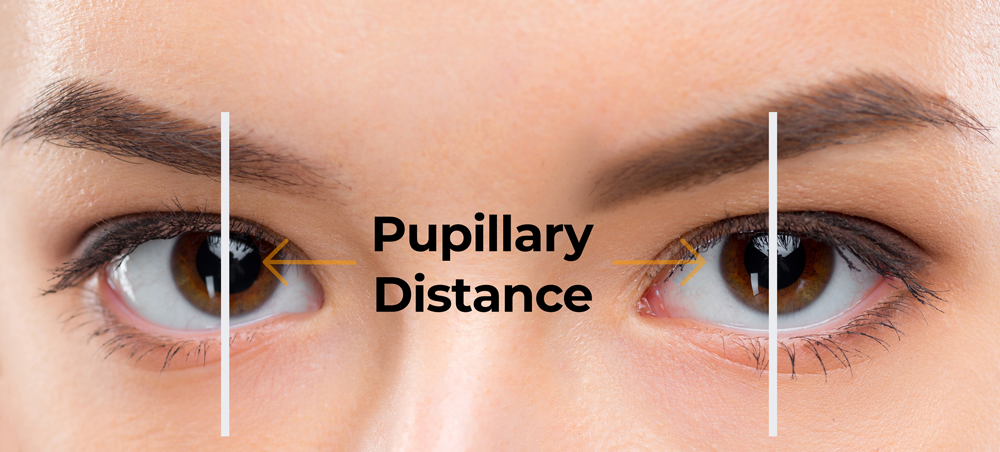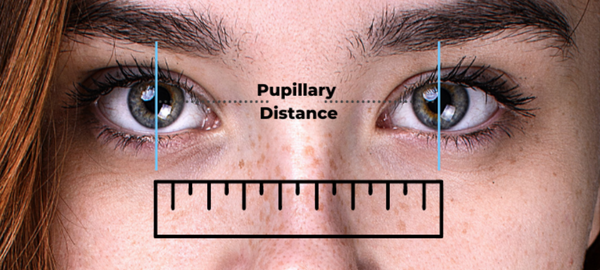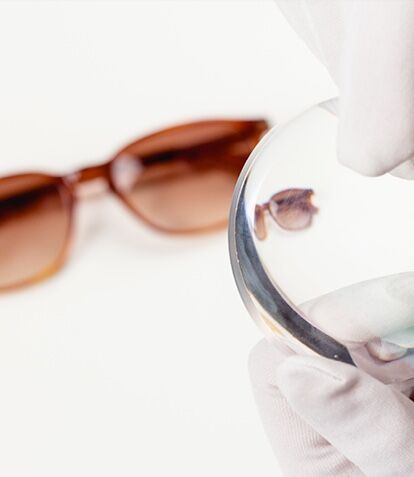
Hva er pupilleavstand? (og hvordan måler du den?)
Visste du at du kan ha briller med perfekt styrke, men uten å ha målt pupilleavstanden din har ikke det noen betydning. ‘’Hva er pupilleavstand’’, lurer du kanskje på? Det er et vanlig spørsmål som brillebrukere bør kunne svaret på.
Effekten av å feil pupilleavstand kan være stressende, og symptomene kan påvirke oss i hverdagen. Hvis du ikke er klar over hvorfor du opplever symptomene kan det være enda mer stressende. Derfor skal vi nå gå igjennom alle spørsmål og svar angående pupilleavstand.
Hva er pupilleavstand?
Pupilleavstand, også kjent som PD er avstanden mellom pupillene dine i milimeter. Øyelegen eller optikeren din kan måle pupilleavstanden din slik at brillene passer deg perfekt.
Du er kanskje kjent med konseptet; optikeren din bør kunne gi deg pupilleavstanden din etter en undersøkelse?
Gjennomsnittsavstanden for de fleste voksne er mellom 55 og 70mm, og for barn er den mellom 42 og 54mm. For noen er den derimot annerledes de typiske målingene.
Det finnes teknologi som kan måle avstanden din nøyaktig. Les videre.
Hvordan måle pupilleavstanden?
Det finnes 4 måter å måle pupilleavstanden, med hjelp fra noen, gjør det selv, bruk et verktøy online, eller bruk en app. Vi snakker mer om det senere i artikkelen.
Først skal vi se på hvordan man måler pupilleavstanden ved hjelp av noen andre. Du trenger en linjal, et annet menneske og et par øyne.
Her er noen tips du kan bruke når noen andre skal hjelpe deg:
• Få de til å sitte på huk når du står opp slik at de er utenfor synsfeltet ditt
• Hold øynene dine så stille som mulig
• Se over hodet på dem og fokuser på noe et par meter bort
Steg 1 – Hold linjalen over nesebroen din
Steg 2 – Ha en venn stående ca en armlengde unna deg
Steg 3 – Lukk høyre øye og sørg for at pupille avstands linjalen null er på linje med venstre pupill. Sørg for at din venn er oppmerksom nå
Steg 4 – Hold linjalen stille. Se rett fram, lukk ditt venstre øye og åpne ditt høyre øye
Steg 5 – Få vennen din til å lese av nummeret som er på linje med din høyre pupill. Dette er pupilleavstanden din. Du trenger å få målet i millimeter for at det skal være nøyaktig. Midt på din høyre pupill.
Steg 6 – Gjør det samme igjen for å sørge for rett måling.
I neste eksempel skal vi se på hvordan du kan måle avstanden selv. Du trenger bare en linjal og et speil. Enkelt og greit.
Steg 1 – Hold linjalen over nesebroen. Hvilken som helst millimeter linjal funker fint
Steg 2 – Se mot et speil
Steg 3 – Lukk ditt venstre øye. Samtidig som du ser i speilet sørg for at linjalens null er på linje med din venstre pupill.
Steg 4 – Hold linjalen stille. Se rett fram, lukk ditt venstre øye og åpne ditt høyre øye.
Steg 5 – Les av tallet som er på linje med din høyre pupill. Dette er pupille distansen din. Husk at du trenger den i nøyaktig millimeter.
Steg 6 – Gjør samme prosess om igjen for å sørge for et nøyaktig resultat.
Til slutt, hvis du vil måle avstanden enklest mulig kan du gøre det online hos SmartBuyGlasses, med den avanserte pupille avstands måleren.
Bruk verktøyet online, ha et kreditt kort tilgjengelig og sørg for å ha et fungerende webkamera. Len deg tilbake og følg med på instruksjonene.
Se på bildet under:

Hva skjer hvis du har feil pupilleavstand på brillene?
Dette er noe av det viktigste vi ville dekke. Det er viktig å huske på at selv den minste feil kan forårsake frustrerende problemer med synet. Dette må korrigeres så snart som mulig. Ikke ignorer problemer som dette.
De fleste vil gå i perioder uten å vite hvilken pupille avstand de har, og de vil oppleve symptomer de ikke kan finne svar på.
En unøyaktig PD kan føre til irriterte øyne. Det kan også føre til hodepine, uklart syn og tretthet. Alt dette kan forverres over tid og føre til utmattelse.
Du visste kanskje ikke hvor mye dette kan påvirke øyehelsen din og helsen din generelt? Hvis du har noen av disse symptomene eller kjenner at brillene dine ikke fungerer helt for deg, husk at dette kan og bør fikses.
Start med å mål pupilleavstanden din online, og kontakt optikeren din å forklar problemet.
Konklusjon
Nå vet du at pupilleavstanden din (PD) er avstanden mellom pupillene dine og at en feilaktig PD kan forårsake diverse problemer som du bør ta tak i så snart som mulig.
Nå som du kan måle avstanden din online, med eller uten assistanse kan du være trygg på at du har all informasjon du trenger for å kjøpe briller med nøyaktig distanse fremover.
Hvis du er på utkikk etter nye briller med korrekt PD vet du om de forskjellige metodene du kan bruke. Hvilken metode velger du?
Hva er pupilleavstand? (og hvordan måler du den?)

Visste du at du kan ha briller med perfekt styrke, men uten å ha målt pupilleavstanden din har ikke det noen betydning. ‘’Hva er pupilleavstand’’, lurer du kanskje på? Det er et vanlig spørsmål som brillebrukere bør kunne svaret på.
Effekten av å feil pupilleavstand kan være stressende, og symptomene kan påvirke oss i hverdagen. Hvis du ikke er klar over hvorfor du opplever symptomene kan det være enda mer stressende. Derfor skal vi nå gå igjennom alle spørsmål og svar angående pupilleavstand.
Hva er pupilleavstand?
Pupilleavstand, også kjent som PD er avstanden mellom pupillene dine i milimeter. Øyelegen eller optikeren din kan måle pupilleavstanden din slik at brillene passer deg perfekt.
Du er kanskje kjent med konseptet; optikeren din bør kunne gi deg pupilleavstanden din etter en undersøkelse?
Gjennomsnittsavstanden for de fleste voksne er mellom 55 og 70mm, og for barn er den mellom 42 og 54mm. For noen er den derimot annerledes de typiske målingene.
Det finnes teknologi som kan måle avstanden din nøyaktig. Les videre.
Hvordan måle pupilleavstanden?
Det finnes 4 måter å måle pupilleavstanden, med hjelp fra noen, gjør det selv, bruk et verktøy online, eller bruk en app. Vi snakker mer om det senere i artikkelen.
Først skal vi se på hvordan man måler pupilleavstanden ved hjelp av noen andre. Du trenger en linjal, et annet menneske og et par øyne.
Her er noen tips du kan bruke når noen andre skal hjelpe deg:
• Få de til å sitte på huk når du står opp slik at de er utenfor synsfeltet ditt
• Hold øynene dine så stille som mulig
• Se over hodet på dem og fokuser på noe et par meter bort
Steg 1 – Hold linjalen over nesebroen din
Steg 2 – Ha en venn stående ca en armlengde unna deg
Steg 3 – Lukk høyre øye og sørg for at pupille avstands linjalen null er på linje med venstre pupill. Sørg for at din venn er oppmerksom nå
Steg 4 – Hold linjalen stille. Se rett fram, lukk ditt venstre øye og åpne ditt høyre øye
Steg 5 – Få vennen din til å lese av nummeret som er på linje med din høyre pupill. Dette er pupilleavstanden din. Du trenger å få målet i millimeter for at det skal være nøyaktig. Midt på din høyre pupill.
Steg 6 – Gjør det samme igjen for å sørge for rett måling.
I neste eksempel skal vi se på hvordan du kan måle avstanden selv. Du trenger bare en linjal og et speil. Enkelt og greit.
Steg 1 – Hold linjalen over nesebroen. Hvilken som helst millimeter linjal funker fint
Steg 2 – Se mot et speil
Steg 3 – Lukk ditt venstre øye. Samtidig som du ser i speilet sørg for at linjalens null er på linje med din venstre pupill.
Steg 4 – Hold linjalen stille. Se rett fram, lukk ditt venstre øye og åpne ditt høyre øye.
Steg 5 – Les av tallet som er på linje med din høyre pupill. Dette er pupille distansen din. Husk at du trenger den i nøyaktig millimeter.
Steg 6 – Gjør samme prosess om igjen for å sørge for et nøyaktig resultat.
Til slutt, hvis du vil måle avstanden enklest mulig kan du gøre det online hos SmartBuyGlasses, med den avanserte pupille avstands måleren.
Bruk verktøyet online, ha et kreditt kort tilgjengelig og sørg for å ha et fungerende webkamera. Len deg tilbake og følg med på instruksjonene.
Se på bildet under:

Hva skjer hvis du har feil pupilleavstand på brillene?
Dette er noe av det viktigste vi ville dekke. Det er viktig å huske på at selv den minste feil kan forårsake frustrerende problemer med synet. Dette må korrigeres så snart som mulig. Ikke ignorer problemer som dette.
De fleste vil gå i perioder uten å vite hvilken pupille avstand de har, og de vil oppleve symptomer de ikke kan finne svar på.
En unøyaktig PD kan føre til irriterte øyne. Det kan også føre til hodepine, uklart syn og tretthet. Alt dette kan forverres over tid og føre til utmattelse.
Du visste kanskje ikke hvor mye dette kan påvirke øyehelsen din og helsen din generelt? Hvis du har noen av disse symptomene eller kjenner at brillene dine ikke fungerer helt for deg, husk at dette kan og bør fikses.
Start med å mål pupilleavstanden din online, og kontakt optikeren din å forklar problemet.
Konklusjon
Nå vet du at pupilleavstanden din (PD) er avstanden mellom pupillene dine og at en feilaktig PD kan forårsake diverse problemer som du bør ta tak i så snart som mulig.
Nå som du kan måle avstanden din online, med eller uten assistanse kan du være trygg på at du har all informasjon du trenger for å kjøpe briller med nøyaktig distanse fremover.
Hvis du er på utkikk etter nye briller med korrekt PD vet du om de forskjellige metodene du kan bruke. Hvilken metode velger du?

















































